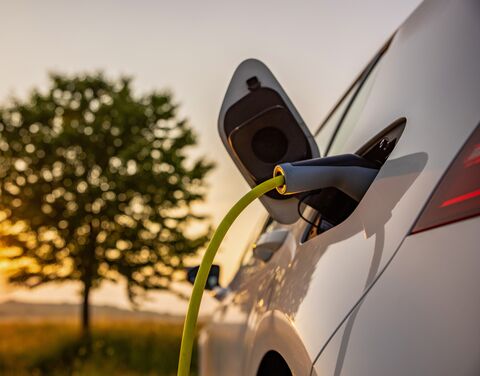
Bidirectional charging means being able to use an electric vehicle to not only receive electricity, but also to store electricity and feed it back into the grid. If you own an EV, it’s well worth looking into this new development, and this article will tell you all about it.
Often the main problem with renewable energy is storing the electricity. This is because the solar panels on your roof generate electricity when the sun is shining, which is not necessarily when you need the electricity. Ideally, this surplus energy should be stored somewhere. There are special batteries that do this, but this is an added cost. This is where bidirectional charging comes in. It allows your EV to be used as a battery to store this energy. Usually you charge your EV with electricity so you can drive it. But with the right technology, you can pull electricity from your car, which lets you store excess energy from your solar panels, for example, and feed it back into the grid later on.
In charging and discharging, the difference between direct and alternating current plays a decisive role. Alternating current (AC) is what is used in households. When transferring energy between the grid and an electric vehicle, alternating current is generally converted to direct current by an internal converter in the on-board charger (OBC) of the vehicle in order to charge the car battery. For the house or the grid to be able to use the electricity, it must be able to flow in the other direction. This is why the Wallbox or the car needs to have a converter, which enables the battery to convert the direct current from the battery to alternating current.
There are various ways in which the electricity stored in the car can be used. They are usually referred to as Vehicle-to-Everything, or V2X for short. Below is a rundown of the three most popular options:
ISO 15118-20 is an international standard for bidirectional charging of electric vehicles. It defines the interfaces and communication protocols between the vehicle and the charging infrastructure. It also defines how information about the battery’s state of charge and the current flow is exchanged.
Bidirectional charging has the potential to be applied in different areas, making a significant contribution to the energy transition and to sustainable energy supply.
The number of electric cars in Switzerland is steadily increasing – at the end of 2024, there were over 203,000, or 4.2% of all passenger cars. Nevertheless, there is still some catching up to do with bidirectional charging, as society’s benefits of this rate are still relatively low. If the trend towards electric cars continues, greater progress can be expected here.
Although bidirectional charging offers numerous advantages, there are several technical challenges that still need to be resolved if the system is ever to become mainstream:
Bidirectional charging will only establish itself once these hurdles are finally overcome. Promising solutions on how to use intelligent charging management systems or how to adapt the grid to Smart Grid technologies do already exist. These are intelligent solutions that will coordinate the production, storage and usage of electricity. Integrating bidirectional charging into efforts to bring us closer to the energy transition can make a significant contribution to sustainable energy supply and reduce our dependence on fossil fuels.
Not all cars provide bidirectional charging. The following vehicles do offer bidirectional charging.
(As of: 10/2024)
More models will be added in the future. A lot of manufacturers have announced that they will be integrating this feature into certain cars. But the car isn’t the only thing that has to be equipped with the technology needed for bidirectional charging. A wallbox with this capability is necessary as well. Some well-known manufacturers include ABB, Entratek, Evtec and Wallbe.
Bidirectional charging is likely to play an ever-growing role in the future. You should try to stay on top of the following developments.
Bidirectional charging is a new technology that makes it possible to send electricity back and forth between a vehicle and the grid. An intelligent control system manages the charging processes and electricity flows in which the vehicle feeds excess energy into the grid or the vehicle is used as mobile energy storage. This opens up numerous potential applications for stabilizing the grid and integrating renewable energies into the grid.
However, there are still some technical challenges in implementing bidirectional charging, such as the lifespan of car batteries, adapting the grid and drafting the necessary regulations and legal framework. Both companies and legislators need to make headway in order to make this technology affordable for everyone and to convince end-users that it’s worth the investment.
Bidirectional charging makes it possible for EVs not only to draw energy from the charging infrastructure, but also to feed excess energy from the car battery back into the grid.
Bidirectional charging offers several advantages, such as the ability to stabilize the grid and make better use of renewable energies. It can also help bring down the costs involved in expanding the grid, since the batteries of electric cars can serve as temporary energy storage.
Bidirectional charging requires a charging infrastructure and an electric vehicle with bidirectional charging equipment. During charging, energy from the charging infrastructure is transferred to the vehicle battery. During discharging, the energy from the vehicle battery is fed back into the charging infrastructure. This is useful, for example, when the photovoltaic installation generates electricity that is not immediately consumed.
There is no law forbidding bidirectional charging, which means you can use bidirectional charging within the framework of applicable rules and with products (E-Auto, Wallbox) suited to this purpose.